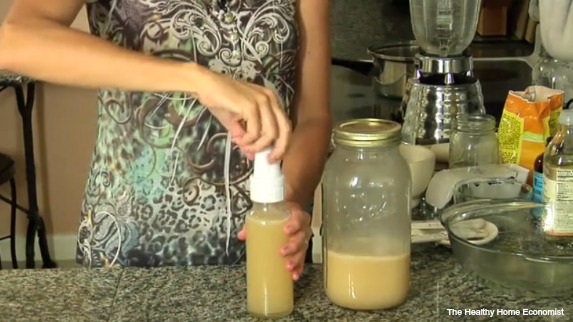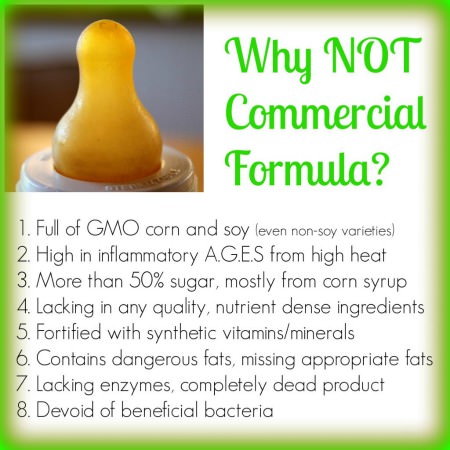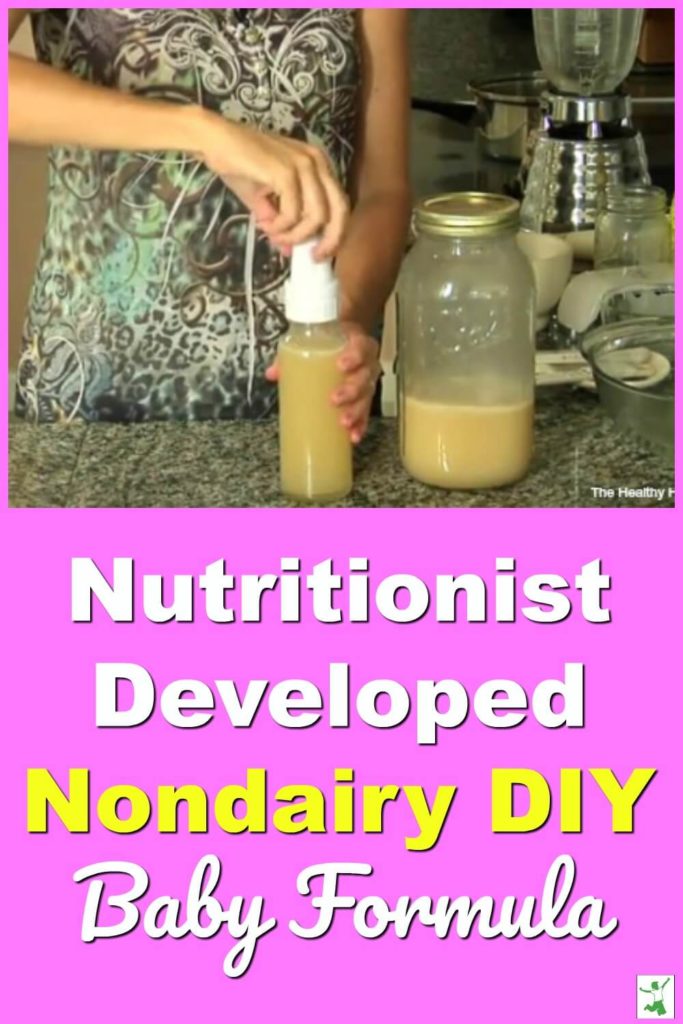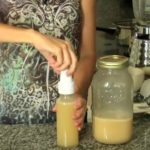Table of Contents[Hide][Show]
A nourishing, hypoallergenic homemade baby formula using safe, whole ingredients. This recipe was developed and tested by Dr. Mary Enig, a PhD Nutritionist and originally published in Nourishing Traditions cookbook in 1996. Source: Weston A. Price Foundation

Many health-conscious parents first try a homemade milk-based baby formula when it becomes apparent that breastfeeding is not an option. If baby demonstrates an intolerance even when using fresh, grass-fed whole milk or yogurt, the non-dairy homemade formula recipe is an excellent alternative to use instead. A detailed how-to video tutorial is also provided.
This dairy-free DIY formula is based on homemade broth and a small amount of cooked, organic grass-fed liver instead of milk as the source of protein.
The recipe was originally published in the cookbook Nourishing Traditions in 1996 and developed by Dr. Mary Enig.
Traditional cultures sometimes used liver pre-chewed by the Mother as a baby first food. Liver is very easily digested and full of nutrition and cholesterol for the baby’s rapidly developing brain.
Commercial nondairy formulas rely on soy as the protein source. Soy formula is a devastating food for babies as it is loaded with plant estrogens which wreak havoc with the baby’s developing hormonal system. In addition, soy contains some of the highest levels of phytic acid found in any food. Phytic acid contributes to poorly developed, cavity-prone baby teeth and poor bone structure (i.e., turned-in feet, flat feet, crowded teeth, sunken chest, etc) as it blocks mineral absorption.

Whatever you do, if your child cannot drink a milk-based formula, DO NOT use soy! Other types of plant-based DIY baby formula can cause growth problems as well.
What a relief for a concerned parent that a safe, healthy, non-dairy homemade formula can be made at home with nutrient-dense, whole-food ingredients.
Most babies who cannot drink the homemade milk-based formula THRIVE on this hypoallergenic homemade formula.
You will immediately notice that whey and lactose are used in this hypoallergenic recipe. The vast majority of babies will do fine with these milk-derived ingredients as it is the milk protein (casein), not the lactose or whey that was causing the problems with the milk-based formula. In the rare case that the infant is not thriving on this homemade dairy-free formula, remove the whey and substitute GMO-free dextrose or sucrose for the lactose.
Nondairy Homemade Formula
Click here for where to source all the ingredients for the dairy-free homemade formula such as gelatin, lactose, and acerola powder, etc. See the dairy-free baby formula video below for visual details.
One batch of 36 ounces takes about 10 minutes to make.
Be sure to use bottle nipples designed for thicker flowing liquids when feeding this formula to your baby. Get them here.
If your baby is only allergic to cow milk, but not other types of dairy, this article provides a how-to for making homemade goats milk formula if you would like to try that first. A sheep milk formula is an option too. Or, if you cannot get goat milk in your area, you can make homemade formula with camel milk.


Dairy-Free Homemade Formula Recipe
A nourishing, dairy-free homemade baby formula that uses bone broth as the base instead of raw milk that was developed and tested by Dr. Mary Enig to match breastmilk as closely as possible.
Ingredients
- 3 3/4 cups bone broth
- 2 oz grassfed liver beef, bison, or lamb
- 1/4 cup liquid whey leave out if baby cannot tolerate
- 5 Tbl goat lactose OR nonGMO dextrose if baby cannot tolerate
- 1/4 tsp bifidobacterium infantis powder
- 1/2 tsp cod liver oil unflavored
- 1 tsp sunflower oil preferably organic
- 2 tsp extra virgin olive oil preferably organic
- 1 Tbl virgin coconut oil preferably organic
- 1/4 tsp acerola powder
Instructions
-
Simmer liver cut up into small pieces gently in the homemade broth until just cooked through.
-
Liquefy the liver in the broth using a handheld blender or a food processor.
-
Let the broth cool to room temperature, then stir in the remaining ingredients or blend for a few seconds in a blender.
-
Store formula in glass jars in the refrigerator.
-
To serve the homemade formula, pour into glass baby bottles and warm in a baby bottle warmer or in a pan of hot water. Never microwave baby bottles!
Recipe Video
Recipe Notes
You may make bone broth yourself (most budget-friendly) or buy it. Be aware that almost all bone broth on the market is not good quality. Even if it is quality bone broth, it comes in toxic packaging. Watch out! The only brand I have found as of this writing that is worth purchasing is bone broth packaged in shelf stable glass jars.
Most babies allergic to milk formula are allergic to the milk proteins, so liquid whey is tolerated well. If baby shows signs of intolerance try using goat whey (strained from goat yogurt or goat kefir). Leave out only as a last resort. DO NOT use powdered whey from the store or whey from making cheese.
Substitute nonGMO dextrose or sucrose if the baby cannot tolerate lactose.
If your baby has a true dairy allergy and is not just dairy sensitive, this infant probiotic is dairy free to use as a substitute.
**Do not use krill oil as a substitute for the cod liver oil. It contains no Vitamin D and very little Vitamin A.








HI Sarah!
Well, we’ve been trialing raw goat milk this week. I’ve just given her an ounce here and there. Sadly, I’m suspecting her tummy being pretty upset. So, I think I will move to this version of homemade formula? For some reason, it doesn’t seem as ‘trusting’ b/c how do we really know how many minerals/vitamins are being extracted from the broth? I’m going to give it a go, though! I’ve just got to get her off of this neocate. She is doing better than the last time I wrote, though, but still not thriving on ‘goodness’ from nature!
I’m going to go w/ chicken broth, I believe. Just cover a whole chicken w/ water…add some vinegar, and simmer for 48 hours is my plan. I need to research what you have on here for homemade broths for babes. If I’m missing something…can you let me know?
Thank you so much again, Sarah. SO ready for a healthy feeding rhythm!
Hi Angie, chicken broth should work fine. Let me know how it goes!
Thank you, Sarah!
I haven’t prepared it yet. I’ve also been calling our local goat farm and looking into that option as well. I guess I’m just not sure what DD is not able to tolerate – other than commercial dairy formula. I’m not sure how she would do w/ whey or lactose….or perhaps it was just the casein.
Anyway…I will let you know if we go this route. I am SOO ready to feel good about what I’m feeding her!!
Hi Angie, can’t wait for you to report back on how your daughter is doing!
Hi Sarah,
I noticed that you can use broths made from a variety of meats. Is there a reason pork is excluded? Thanks.
This is so awesome! Our adopted dd was born 6 weeks premature on 1-28-11. Trying to feed her processed formula has been a constipation nightmare, which has her sleep-deprived parents frantically searching for an alternative solution. Thanks for giving us hope! We’re going to give the milk-based formula a try, even though I do have some apprehension about how she will do with it.
In case she has trouble, I’ve been looking at the possibility of making this hypoallergenic recipe. I have some chicken and beef livers (naturally raised) that I’ve had in the freezer for probably close to 5 years. Is there a “freezer life” for food?
Secondly, I was looking for your recipe for homemade broth and I couldn’t find it. Thanks for pouring yourself out that we might learn to better nourish ourselves and our families! God bless you and this ministry!
Hi Sarah,
I finally was able to find a farmer that sells grass fed beef and I have the liver to make the formula with. However, he only sells it by the pound but comes frozen. Can I cook all the liver at once and separate it into 2 ounce portions and freeze them ? Would this undermine the nutritional value of liver ? Any suggestions would help. Thanks.
Hi Nolvia, yes that is fine. Cook it all up and freeze in 2 oz portions is a great idea.
Hello!
I am having a terrible time feeding my daughter – 4 months old. I was unable to breastfeed due to medical reasons – I SOO wish I could breastfeed!
Anyway, she cannot tolerate dairy based formula, nor soy. Her pediatrician has her on “neocate”, an elemental baby formula. It has been 8 days and she isn’t doing well. Nightwakings, constant moaning from gas and a tummy ache, and is super irritable and almost hyper I would say. I’m so scared that the first ingredient is corn syrup. My husband and I even steer clear of it and here I’m giving it to my infant as her source of nutrition!
I KNOW my ped wouldn’t go for a homemade formula, but obviously nothing he has suggested is working. Is my wee one too young to try this? I need a nutritionist to help me and guide me through this as I’m scared to try anything at this point b/c she has reacted to everything it seems. I just don’t know where to turn anymore…we need some sleep after 4 months of a colicky unhappy little girl. I long for peace for her…and my hubby and I!
Any thoughts? Thank you so much for your time and advice!
Angie
Angie, your child is not too young to use this formula. This recipe is fine to use for a baby this young. Please make some as soon as you can and let me know how your DD is doing.
Hi Sarah,
This formula interest me but i have a few questions. Firstly, where is the calcium in this formula? Is that not important for a growing baby? Also, everyone tells me that liver is high in Vitamin A and along with the cod liver oil it will be toxic for a baby. Thanks for your help , your website is awesome and life changing.
Hi Nolvia, the calcium is in the homemade broth – plenty of it! 🙂 Liver is indeed high in vitamin A but in amounts that are necessary for the growing baby. The fermented cod liver oil recommended in this recipe is not toxic in the least. Some of the industrialized cod liver oils on the market are to be avoided but this particular brand is safe and nutritious as it is made the traditional way which most on the market are not. Most women have little vitamin A in their breastmilk as they don’t eat enough and plant based sources such as carrots do not convert well to true vitamin A in the gut which is why it is best to get it from a nutrient dense source such as liver.
Hello Sarah, I am so glad to have found your website. I have a s month old and I was told she has eczema and I was told to take out all sugars and milk from her diet. Is there anything I may use to repalce sugar in the hypoallergenic formula. I know you use lactose in this formula and its sugar, would this work or is there something else. Thank you so much.
Bernease,
Hi Bernease,
The lactose should really be fine .. there is lactose in large amounts in human breastmilk after all. Give it a try. I really do think you will be delighted at how your baby thrives. Welcome to the blog, by the way! 🙂
Hi Sarah,
Would this formula be good for a toddler (almost 19 months) or do you know of any other home made recepie for formular for toddlers. My son is almost 19 months old and has been breastfed since his birth. He is very picky eater and very slow to gain weight (currently 20lbs and 6 oz). His GI doctor put him on appeatite medication, which did help, but I would like to take him off of it. My biggest challenge to get my son to eat protein. He is still breastfed before naptime, bedtime and at night and drinks only water. He doesn’t drink milk or eat yogurt. Also, how palatable is this formular?
Thank you so much
Tatyana
Hi Tatyana, typically the toddlers transition to regular fresh milk from the farm (raw) at one year.
Nice! Wish I’d known about this months ago when I had to stop breastfeeding my son at 8 months old. For a kidney problem I have, I had to take maintenance antibiotics every day, and it seemed to really affect his poor digestive tract. He did so much better when I weaned him. But if I had known you could make your own hypoallergenic formula, I would not have had to even try the Nutramigen or Alimentum or any of those. I hate how the first ingredient is corn syrup solids (are you KIDDING me???), and Lord knows what else. Plus the mix just SMELLS awful, and my son hated it too. He was drinking just barely enough to stay hydrated. Fortunately I ignored my pedi’s advice and went with my Mommy instincts, and gave him Oat Milk. He sucked down a full bottle and then promptly slept for 5 hours straight ( way longer than I had ever had him sleep before without waking).
Anywho, he’s just doing regular cow’s milk now, and is healthy as can be. We’re still working on the sleeping issues, but they are much improved.
Now I know where to look if I need this for another baby down the line!
Thanks~
What is Oat Milk???? Do you mean Goat Milk?? I am very interested in another hypoallergenic formula!